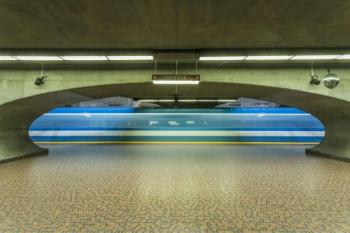Métro train speeds
Métro train operating modes
 Beyond slowing down before entering a station and then accelerating to continue down the track, what determines the other types of variations in a métro train’s speed?
Beyond slowing down before entering a station and then accelerating to continue down the track, what determines the other types of variations in a métro train’s speed?
The Montréal métro’s trains run automatically. Signals transmitted by equipment installed on the track adjust their speed when they are moving. Train speed is regulated according to “track segments.” Acceleration and deceleration are adjusted based on your comfort and safety.
Sometimes, there are changes in the train’s speed signals, like when it is approaching a terminus, for example. In automatic mode, the train quickly reacts to these types of signal changes, but sometimes, the operator takes over in manual mode. This way, the operator can anticipate changes in speed.
The control room’s eyes and ears
Seated in the cab at the front of the train, the operator is the métro control centre’s eyes, ears and even nose. The operator communicates even the slightest suspicious noise, situation or smell to ensure that the tunnels are safe. They are constantly on the lookout and serve as a one-person security system. They can report an anomaly or stop the train as needed. They also watch out for people who seem to be in distress on the platforms or in the tunnel. If they see someone, they alert the control centre, which ensures that the next train will enter the station more slowly. In the meantime, a station officer can be sent out to check on the situation. Communication between stations, trains and the control room is constant.
Problem with a train door? The operator will also be the one who goes to check on it and usually solve the problem. If necessary, they can close and lock the door until it is fixed.
When the train slows down but is not arriving at a station
Beyond slowing down before entering a station and then accelerating to continue down the track, what determines the other types of variations in a métro train’s speed?
A train slows down or stops somewhere other than at a station in certain situations. For example, maintenance work can sometimes require scaffolding from platform to platform. When approaching this kind of work, the train will be asked to slow down so that the air currents do not disturb the workers or the temporary structures. Like all speed signal changes, a deceleration request is communicated to the train by the track’s signaling equipment, which sometimes causes a jolt that passengers feel inside the train.
Example: Construction at Beaudry station
Sometimes, the operator will take control of the train in manual mode. This was the case, at Beaudry station, closed in 2019 for major repair work, the train did not stop there. He was, however, required to cross the station at reduced speed for many reasons. Primarily so that it does not stir up or displace any dust in the tunnel. The dust could hinder the work or blow around and be misconstrued as smoke. The same goes for smells caused by work, such as welding, that could be interpreted as the start of a fire.
Beaudry station is also close to Berri-UQAM, where the flow of passengers in transit requires the train to stop for longer. To maintain consistent train frequency on the line during peak hours, the train must stop at the closed station for a few seconds (approximately 30), under the watchful eye of the métro control room and with the expertise of the métro operator.